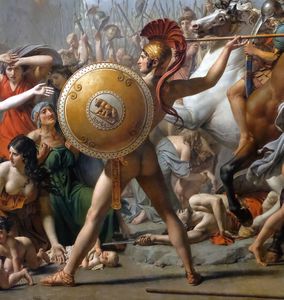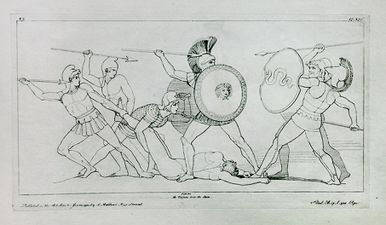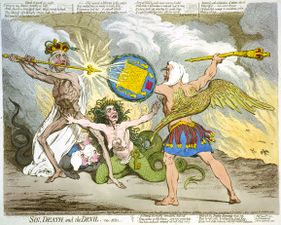تدخل نساء السابين
| The Intervention of the Sabine Women | |
|---|---|
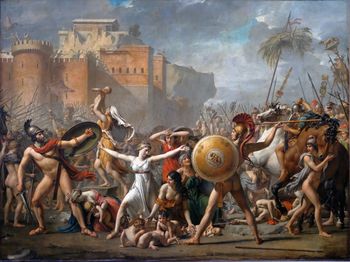 | |
| الفنان | Jacques-Louis David |
| السنة | 1799 |
| الأبعاد | 385 cm × 522 cm (152 in × 206 in) |
| الموقع | Louvre |
The Intervention of the Sabine Women is a 1799 painting by the French painter Jacques-Louis David, showing a legendary episode following the abduction of the Sabine women by the founding generation of Rome.
David began planning the work while he was imprisoned in the Luxembourg Palace in 1795. France was at war with other European nations after a period of civil conflict culminating in the Reign of Terror and the Thermidorian Reaction, during which David had been imprisoned as a supporter of Robespierre. David hesitated between representing either this subject or that of Homer reciting his verses to his fellow Greeks. He finally chose to make a canvas representing the Sabine women interposing themselves to separate the Romans and Sabines, as a "sequel" to Poussin's The Rape of the Sabine Women.
Work on the painting commenced in 1796, after his estranged wife visited him in jail. He conceived the idea of telling the story, to honour his wife, with the theme being love prevailing over conflict and the protection of children. The painting was also seen as a plea for the people to reunite after the bloodshed of the revolution. Its realization took him nearly four years.
The painting depicts Romulus's wife Hersilia – the daughter of Titus Tatius, leader of the Sabines – rushing between her husband and her father and placing her babies between them. A vigorous Romulus prepares to strike a half-retreating Tatius with his spear, but hesitates.
The rocky outcrop in the background is the Tarpeian Rock, a reference to civil conflict, since the Roman punishment for treason was to be thrown from the rock. According to legend, when Tatius attacked Rome, he almost succeeded in capturing the city because of the treason of the Vestal Virgin Tarpeia, daughter of Spurius Tarpeius, governor of the citadel on the Capitoline Hill. She opened the city gates for the Sabines in return for "what they bore on their arms". She believed that she would receive their golden bracelets. Instead, the Sabines crushed her to death and threw her from the rock, later named for her.
. . . . . . . . . . . . . . . . . . . . . . . . . . . . . . . . . . . . . . . . . . . . . . . . . . . . . . . . . . . . . . . . . . . . . . . . . . . . . . . . . . . . . . . . . . . . . . . . . . . . . . . . . . . . . . . . . . . . . . . . . . . . . . . . . . . . . . . . . . . . . . . . . . . . . . . . . . . . . . . . . . . . . . . .
الوصف
أديل من بلگارد (موديل)[1]
مصادر الإلهام
The table shows an important use of various sources and documents from which David was inspired to conceive his subject, the fruit of research and numerous studies, not only inspired by the antique, but also by Italian masters of the Renaissance like Carrache or Raphaël . One of his albums presents several drawings inspired by engraving from these artists. The first source, identified by contemporaries, is a Faustine medallion reproduced in volume IV of the Supplement to the Book of Antiquity explained and represented in figures by Bernard de Montfaucon representing episode 3 . The most noticed is the reference to the work ofNicolas Poussin , The Abduction of the Sabines and particularly the version of the Louvre.
The idea of the central group of two fighters separated by a character with arms outstretched, was probably suggested, according to Antoine Schnapper, by the drawing of John Flaxman engraved by Tommaso Piroli , Le Combat pour le corps de Patrocle taken from an illustration of the ' Iliad . The character of Romulus also takes up the posture of Phineus as he is represented in Perseus and Phinnea by Annibale Carrache ( Farnese Palace ) 4 . Another identified source is a caricature of James Gillray dated 1792, it is entitled Sin, Death, and the Devil, where the attitudes are almost identical to that of Romulus and Hersilia 5 . Schnapper identifies other borrowings: the background is taken from the Martyrdom of Saint Andrew by the Dominiquin at the church of Sant'Andrea della Valle . A horse head drawn by David, attests by faith to an inscription, from the loan as a model of an engraving by Agostino Veneziano for the horse which turns to the right of the painting, and an engraving by Marc-Antoine Raimondi after The Massacre of the Innocents by Raphaël, is at the origin of the figure of the woman from the front located in the center of the table which covers her head.
Illustration de John Flaxman gravé par Tommaso Piroli, Le Combat pour le corps de Patrocle, 1795.
James Gillray 1792 Sin, Death, and the Devil un des modèles utilisés par David pour la composition des figures centrales du tableau.
le Dominiquin
Martyre de saint André église Sant'Andrea della Valle.Annibale Carrache Persée et Phinnée, fresque du palais Farnèse.
الأهمية
The genesis of Les Sabines and the work itself represented a significant departure for the day.[2] Historical depictions had been typically commissioned. David however, conceived, produced and promoted his work for profit.[3] He produced marketing material to accompany the first exhibition. Le Tableau des Sabines, Exposé Publiquement au Palais National des Sciences et des Arts ("the Tableau of the Sabines, Public Exhibition at the National Palace of Arts and Science") contained his own account of the historic episode and had an endnote explaining his rationale for using nudity in the painting.[4] Its 1799 exhibition attracted a large number of paying visitors for several years. In 1819 David sold Les Sabines and his Léonidas at Thermopylae to the Royal Museums for 10,000 francs.[بحاجة لمصدر]
Starting in 1977, France issued a series of definitive stamps featuring the head of Hersilia based on David's painting.[5]
After the expulsion of artists including David from the Louvre, the painting was held in the ancient church of Cluny, which he used as a workshop. That building is now operated as the Musée de Cluny.
المراجع
- ^ Adèle de Bellegarde (Modèle) Lesamis dumusee.blogspot
- ^ Tony Halliday (2006), "The Trouble with Tatius", Oxford Art Journal 29 (2): 197–211, doi:
- ^ Halliday Tatius p.199 fn.1, quoting Dorothy Johnson: In Search of a Beholder: On the Relation between Art, Audiences, and Social Spheres in Post-Thermidor France, Art Bulletin, vol. 74, 1992, pp. 19–36
- ^ David, Jacques-Louis (1800) (in French), Le tableau des Sabines, exposé publiquement au Palais national des sciences et des arts, Paris: Pierre Didot, https://books.google.com/books?id=ab89AAAAcAAJ, retrieved on 12 December 2016
- ^ Stanley Gibbons Stamps of the World 2012.
وصلات خارجية
- David – The Sabine Women A video discussion about the painting from Smarthistory, أكاديمية خان.
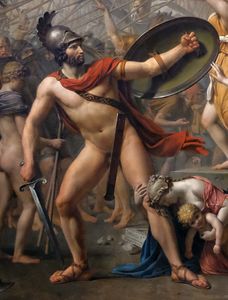

![أديل من بلگارد (موديل)[1]](/w/images/thumb/d/df/F0442_Louvre_JL_David_Sabines_INV3691_detail02_rwk.jpg/224px-F0442_Louvre_JL_David_Sabines_INV3691_detail02_rwk.jpg)
